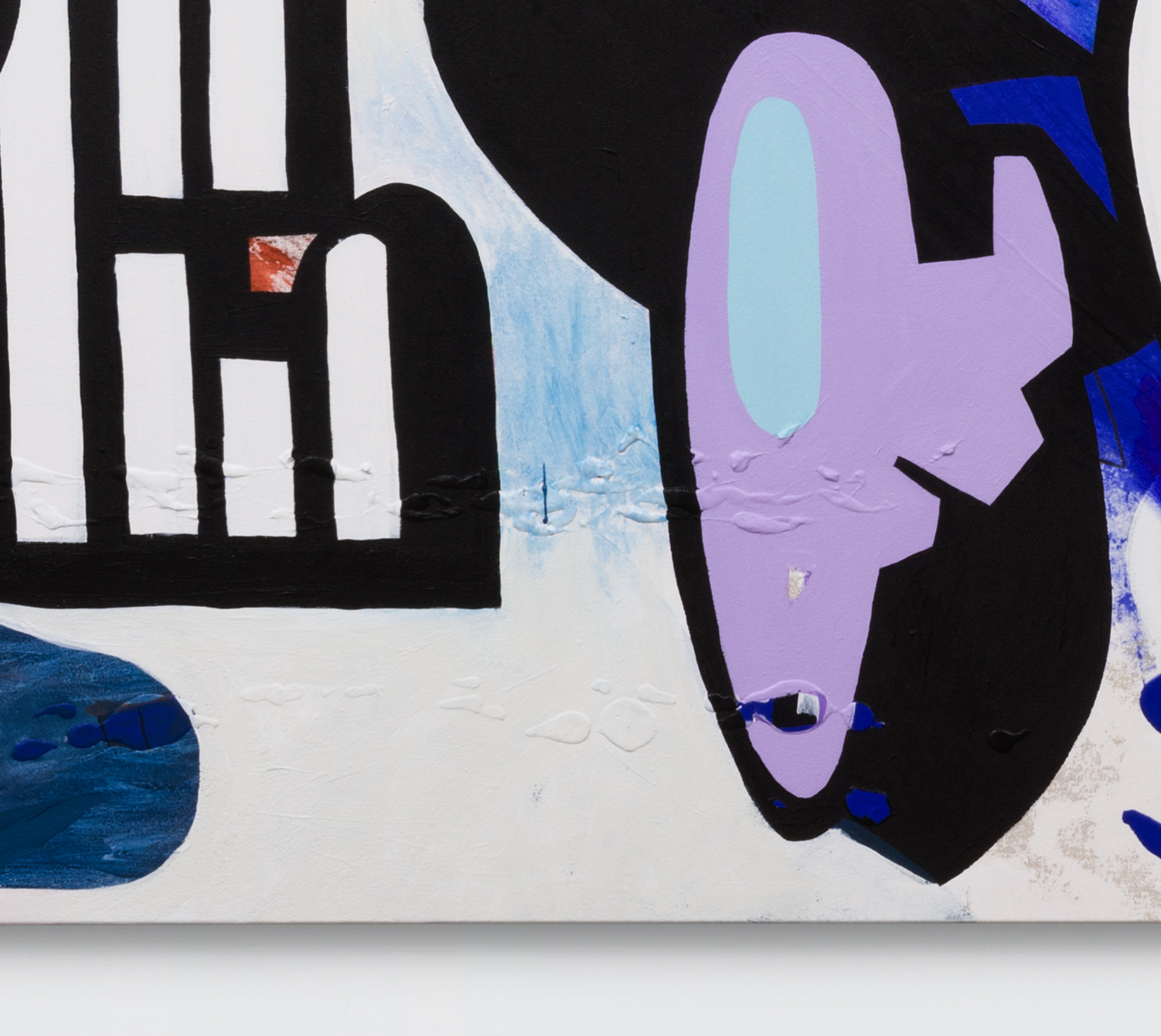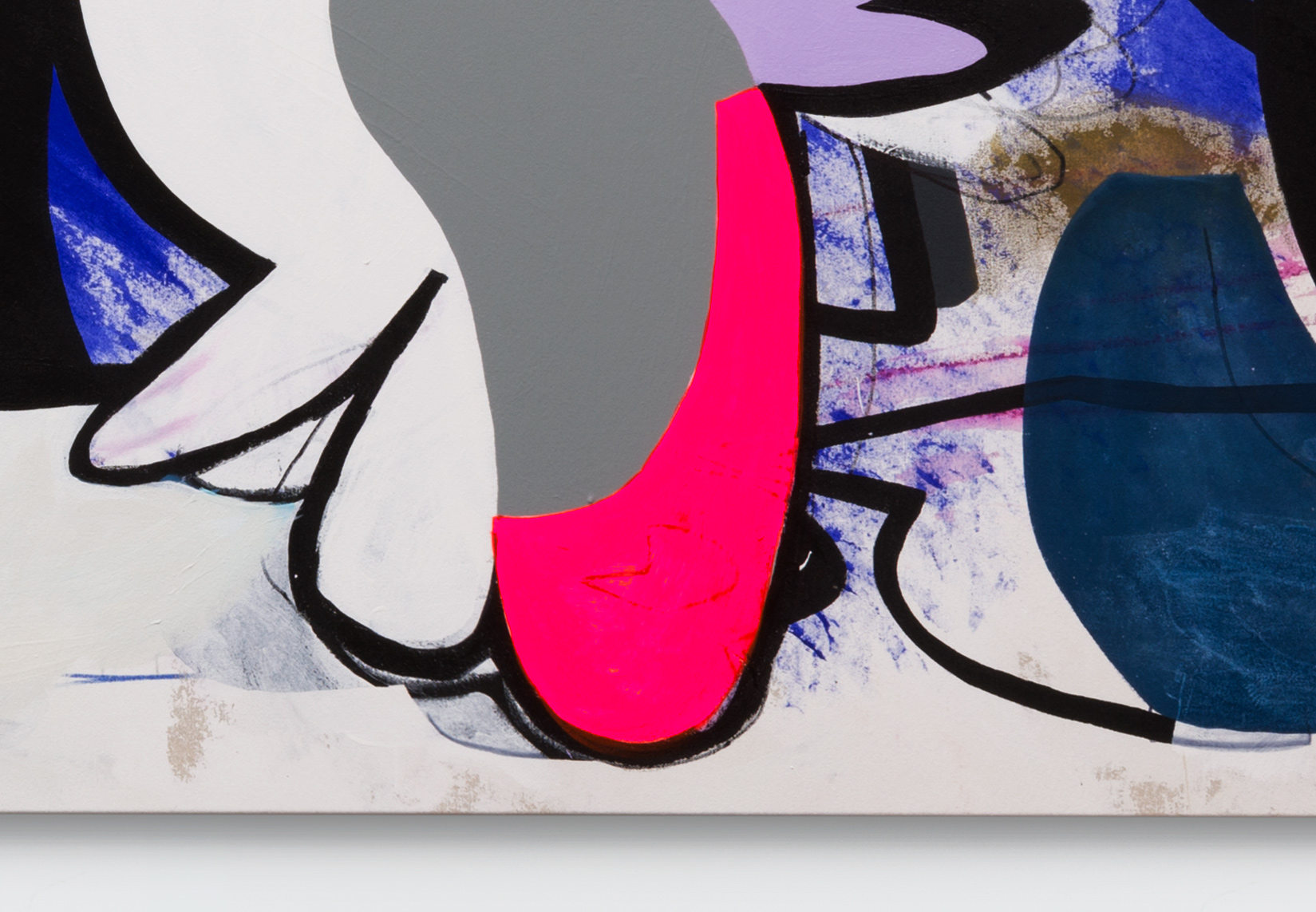︎A Flash of Newness︎Jace Clayton a.k.a. DJ /rupture︎A Flash of Newness︎Jace Clayton a.k.a. DJ /rupture

Tingle, Hayal Pozanti, 2018. Acrylic on canvas, 41” x 121”.
All images courtesy of the artist and Jessica Silverman, San Francisco.
A Flash of Newness
Serendipity in the Digital Domain
Jace Clayton a.k.a. DJ /rupture
Computers can’t generate random numbers. Computers compute: It’s a wonderful, basic thing. That’s what they do. They are calculators, they’re abacuses. Computers are good at generating pseudo random numbers: Look at this chip, look at this timing. But they can’t actually guess. Whatever a computer actually is, something about the irrational or the unknowable—and here I think of Mallarmé’s A Throw Of The Dice Will Never Abolish Chance—is always going be outside their purview.
In order to add that element of the random, or of entropy, or of newness—what is the random, if not a flash of newness?—computers need to go back into the world. They are obviously part of it, but in order to approach something like serendipity they need to sample what we understand as reality. It feels very important to start wrapping our heads around what the digital is, what it can do, and what it can’t do.

Detail of Tingle, Hayal Pozanti, 2018. Acrylic on canvas, 41” x 121”.
I’m co-teaching the Yale School of Art Critical Practice Seminar with Sarah Oppenheimer. She and I met towards the end of 2019. We first crossed paths at a site visit for Cleveland’s Front International Triennial, in Oberlin College’s electronic music studio. She was asking these very pointed, fascinating questions—it’s always great when you come across someone whose lines of inquiry resonate with yours; we were talking about phase oscillation, something she’s been working with spatially, and something that I’d been thinking about because of my work with modular synthesizers. Later, when we discussed the possibility of teaching the seminar, she saw it as an opportunity to collaborate via pedagogy, or pedagogy as collaboration: What would that look like? So here we are! Broadly speaking, instead of focusing on the hermeneutics of completed pieces of art, we’re looking at the poetics. This idea of poiesis, the act of creation, and all the tools and technical concepts. Mainly: What does it actually take to make something? What if we have that as the site of our class? This is very interesting to both of us. Ours is the only official interdisciplinary course for everyone in the four disciplines of the school, and it’s a requirement for all first year students.
Back in October, we brought the seminar to the Leeds Motion Capture Studio at CCAM. In our first class, we had talked about indexicality, and direct mark-making: Physical traces in the material world. We’re linking that through all these different types of image, or representation. So it made sense for us to bring the students into motion capture. We’d already talked about Renaissance perspective, and now we’re inside this Cartesian space. Importantly: It was a chance to play. I myself had never been inside a motion capture studio; all I knew was that there were going to be opportunities for data sonification. When Oppenheimer and I had an introductory conversation with CCAM director Dana Karwas, Dana was explaining the setup and mentioned, Oh, we can put sensors on all 60 students, and have them move as one meta-organism. I immediately said, Yes, great.
These students are already deep inside a very specific route of professionalization at one of the world’s top art schools. There is so much pressure. I see my job as a teacher to knock them off balance a little bit. To remind them that, yes, their art is awesome—but what about the mistakes? What about the messiness? What about collaborative spaces? What about error? What about something that’s not public-facing, especially in this very rare time of graduate school? I wanted us to get into a zone where we’re all complete beginners, and no one except Oppenheimer had had any engagement with motion capture in any sense. The spirit of that was: There is no right or wrong. All the normative quality judgments are simply not there.

Detail of Tingle, Hayal Pozanti, 2018. Acrylic on canvas, 41” x 121”.
When thinking about art-making, or considering the humanities and the digital humanities, an important question is: How do we create a future that doesn’t resemble the past? That’s why I feel that randomness, newness, and serendipity are all part of the same thing. We’re very aware of some of the rules; and a lot of these rules are constraining our behavior in ways that we don’t know yet. For me, being able to talk about randomness—or its flipside, serendipity—is about that. How can change happen? Can change happen?
It was a way to think about entering into the digital, and how the digital allows for the world to be interpreted as data.︎
In 2019, I had an exhibit up in the Nassauischer Kunstverein Wiesbaden in Germany. That piece was partially an exploration of these issues. The title of it was “White Noise as a Call to Responsibility.” I was thinking a lot about white noise machines, the ones you see at therapists’ offices and doctors’ offices; these little white plastic cylinders that just generate fan-sound noise, so that your conversation won’t be overheard. Their use crystallizes the notion that your problems are yours, that your problems are private matters for which you may consult with a professional, but those problems need to be buffered from the outside world. And white noise does the buffering.
But what happens when we realize that so many of our problems are shared, public concerns? That’s one definition of the political: Politics begins when we treat problems that impact us individually with the understanding that they are public problems.
The white noise machine has a very specific history. It was invented in the sixties. First, it was used as a sleeping aid, and then it quickly became popular with the rise of therapy in the States. I was also thinking of white noise in electronic music. The most famous and iconic drum machine is the Roland TR-808. (You know, Kanye West’s 808s and Heartbreak.) It’s almost synonymous with bass. The 808 signature sound has an amazing back story. The Japanese inventor Ikutaro Kaketashi knew that white noise from analog transistors had a really nice quality that you could then sculpt into the ts-ts-ts-ts-ts-ts sound, and use to synthesize the sound of hi-hats and cymbals and drums. But Kaketashi wanted to find the best-sounding white noise. He was listening to all these different kinds. Finally, he found a box of 12,000 discarded, faulty transistors. They’d been made for some sort of electronic application, like radio or TV. But they didn’t work, they weren’t up to spec. Yet to his ears, they had the best-sounding white noise. So he only made 12,000 units of this drum machine, and sold them all. He couldn’t make more, because the original transistors were defective. Nowadays, an original Roland TR-808 goes on sale for thousands of dollars. It’s a collector’s item.

Detail of Tingle, Hayal Pozanti, 2018. Acrylic on canvas, 41” x 121”.
That, to me, is a beautiful moment in the history of randomness. It was the early eighties. Computerized drum machines were finally getting into the hands of the music-making public. These little micro doses of ts-ts-ts-ts-ts-ts in dance music were happening at this very interesting cultural-technical climate. For the first time in human history, people were dancing to completely mechanical rhythms. Music had never been so precisely metronomic prior to this, then suddenly we’re inside the grid. It was also a time of sexual freedom and drug experimentation, with the play of identity that happens in club spaces—that’s all there. But I was really fascinated in how white noise specifically was used. It’s often to indicate the swing of the track, the human push-pull of subjective time. This idea of the kick drum, the four-four: That’s the temporal grid. That’s unchanging. And then the ts-ts-ts-ts-ts-ts, that white noise sound, will often have these moments of rhythmic play, which on a dancefloor, assert a kind of collective fluidity in relation to the machinic grid.
I was really fascinated in how white noise specifically was used. It’s often to indicate the swing of the track, the human push-pull of subjective time.︎
“White Noise as a Call to Responsibility” ran across two rooms. It was a multimedia installation, with a large audio component alongside some companion sculptures and paintings. The sound was a bunch of analog electronics making rhythmic patterns out of white noise. Another part was a chorus of white noise machines. I was using the exhibition form as a way to engage with some of these ideas about randomness and white noise. Thinking of all that, in totality, I realized: That’s part of what makes electronic dance music so engaging. It’s playing with different scales of temporality, and different scales of precision and anarchy, or chaos and serendipity.